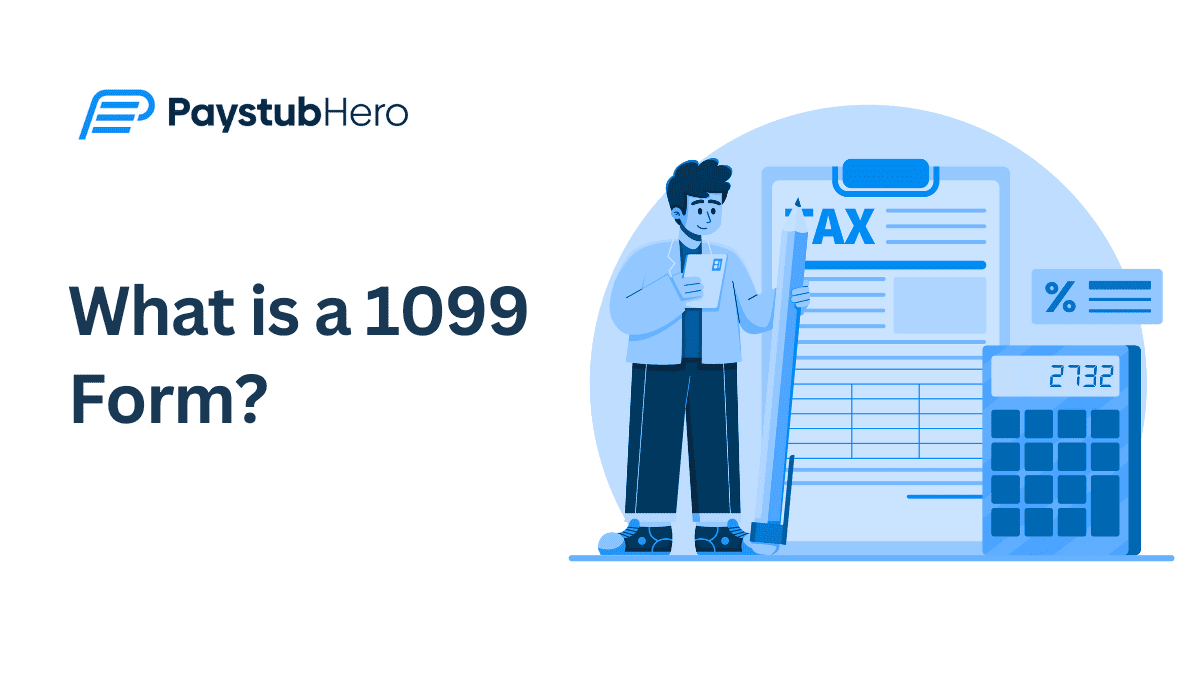A 1099 form is a tax document that shows income you received from sources other than traditional employment. It shows how much you were paid and is used for reporting taxes and other purposes, like applying for a loan.
In this article, we’ll cover the different types of 1099 forms, who receives them, and how to obtain them.
Understanding 1099 Forms
As briefly seen above, a 1099 form is used to report income from sources other than regular jobs, like freelance work, dividends, or rental income. This is different from a W-2 form, which shows wages and includes deductions for Social Security and Medicare.
Knowing the difference between these forms is important for accurate income reporting.
Amount Reporting
The amount shown on a 1099 form represents the total income you received from a specific source during the year.
Usually, a business or individual must provide a 1099 form if they paid you $600 or more in a year for services or other types of income. This amount is important for calculating your taxable income.
For instance, if you worked as an independent contractor and earned over $600, you would get a 1099-NEC form showing the total amount paid to you. Note that the figures on these forms show your gross income.
Also Check: Gross Pay vs Net Pay
This brings us to the different types of 1099 forms. Let’s take a closer look at each one below.
Different Types of 1099 Forms
There are various types of 1099 forms, each with a specific purpose. Let’s break down some of the most common ones:
1099-NEC: Nonemployee Compensation
One of the most commonly used forms in this series is the 1099-NEC, which stands for Nonemployee Compensation. This form is used to report payments made to independent contractors, freelancers, or other self-employed individuals.
If you hire someone to do work for your business but they aren’t classified as an employee, and you pay them $600 or more in a year, you must issue a 1099-NEC.
This amount is considered gross income, meaning it doesn’t account for any business related expenses the individual may have incurred.
Here is an example to illustrate:
Suppose a small business hires a freelance graphic designer to develop a new logo, paying them a total of $1,000 for the project. Since this amount exceeds the $600 threshold, the business must issue a 1099-NEC to the designer, reporting the total payment.
The designer will then include this income on their tax return. They can deduct any related expenses, like software or materials, to calculate their taxable income.
For instance, if the designer spent $300 on design software specifically for the project, their taxable income from this contract would be calculated as follows:
◘ Total Payment Received: $1,000
◘ Expenses: $300
Taxable Income Calculation
◘ Taxable Income = Total Payment Received – Expenses
◘ Taxable Income = $1,000 − $300 = $700
So, the designer’s taxable income from this contract would be $700.
1099-MISC: Miscellaneous Income
The 1099-MISC form is another essential document used to report miscellaneous income that doesn’t fit into other categories. This includes payments like rent, royalties, prizes, awards, and certain types of medical and healthcare payments.
Despite the introduction of the 1099-NEC, the 1099-MISC remains relevant for capturing a wide range of income types.
Continuing with our example, if the small business also rents an office space and pays $24,000 in rent for the year, they would report this amount on a 1099-MISC form.
The landlord, in turn, will use this form to report the rental income on their tax return. The form ensures that all such payments are documented and reported accurately.
1099-K: Payment Card and Third-Party Network Transactions
A 1099-K is a tax form used to report income from payment card transactions and third-party network payments. This includes sales made with credit cards, debit cards, and online platforms like PayPal or Venmo.
The threshold for receiving a 1099-K has changed. Previously, you needed to receive over $600 in payments to get a 1099-K. Starting in the 2024 tax year, the threshold is now $5,000. This means if you receive more than $600 in payments through these channels, you will likely get a 1099-K from the payment processor or platform.
The 1099-K helps ensure all income from digital and card-based payments is reported to the IRS.
Calculate taxable income from a 1099-K:
Let’s revisit our graphic designer. They sell their digital artwork through an online platform and receive a 1099-K at the end of the year. The 1099-K shows total payments of $50,000 for the year.
To determine their taxable income, we need to subtract any eligible business expenses related to creating and selling the digital art. Let’s assume they have $5,000 in deductible expenses for things like software, marketing, and computer equipment.
Here’s the calculation:
◘ Total Payments Received (from 1099-K): $50,000
◘ Business Expenses: $5,000
◘ Taxable Income: $50,000 – $5,000 = $45,000
The graphic designer would report this $45,000 as income on their tax return.
Other Common 1099 Forms
⦿ 1099-DIV:
⦿ 1099-INT:
Reports interest income from bank accounts or other financial institutions.
⦿ 1099-G:
- Reports government payments like unemployment benefits or tax refunds.
Why Do 1099 Forms Matter?
1099 forms are important because they have several key purposes, making them essential for many financial and legal matters.
Proof of Income
One of the key benefits of 1099 forms is that they offer proof of income. For freelancers and independent contractors, these forms act as official records of earnings.
For instance, if a graphic designer earns $8,000 from various clients over the year, each client would issue a 1099-NEC form detailing the payments made.
This documented income becomes important for applying for loans, renting an apartment, or verifying earnings for any official purpose.
Tax Reporting
1099 forms also play an important role in tax reporting. They are submitted to the IRS to report different types of income, ensuring that tax calculations are accurate.
For example, if someone receives $1,500 in dividends from investments, they will receive a 1099-DIV form from their brokerage.
This form helps ensure that all income is reported and taxed correctly. Missing out on reporting income from 1099 forms can lead to penalties and additional taxes.
Financial Planning and Record-Keeping
In addition, 1099 forms are valuable for financial planning and record-keeping. They provide a clear overview of income from various sources. This is essential for effective budgeting and financial management.
By tracking income through these forms, individuals can gain insights into their earning patterns and make more informed decisions.
Compliance and Transparency
Finally, 1099 forms are vital for compliance and transparency. They help individuals and businesses adhere to tax laws and regulations, reducing the risk of legal complications.
For businesses, issuing these forms ensures clear records for audits and reviews.
Together, these functions highlight how crucial 1099 forms are for maintaining accurate financial records and ensuring proper tax compliance.
Need 1099 Forms? Get Them From PaystubHero!
Need reliable proof of income and easy tax reporting? Our service provides accurate and timely documents, making it simple to manage your finances and tax obligations.
Whether you’re freelancing, renting, or applying for a loan, our 1099 forms offer the proof of income you need.
FAQs
Here are some common questions about 1099 forms.
A 1099 is a tax form used to report various types of income you received that wasn't from an employer, such as income from freelance work, rental property, or interest.
If you believe you should have received a 1099 and haven't, contact the payer who should have issued it. If you're unable to resolve the issue, you can contact the IRS for guidance.
Different types of 1099 forms exist, each with specific boxes for different types of income.
Generally, the most important box is Box 1, which shows the total amount of income you received. Consult the IRS instructions for the specific 1099 form you have for detailed explanations.








